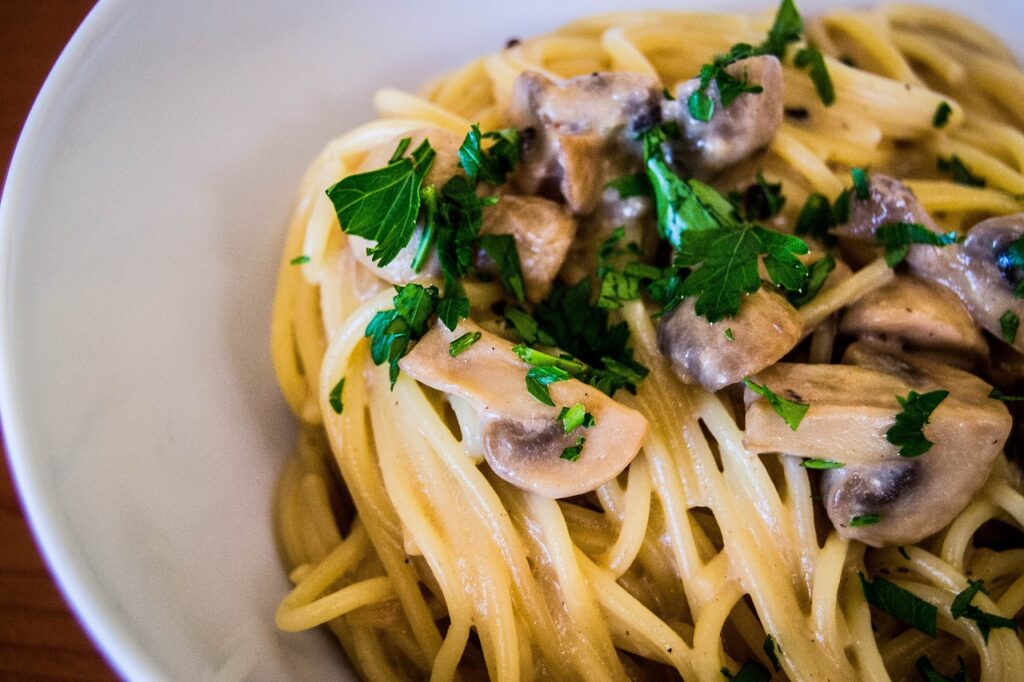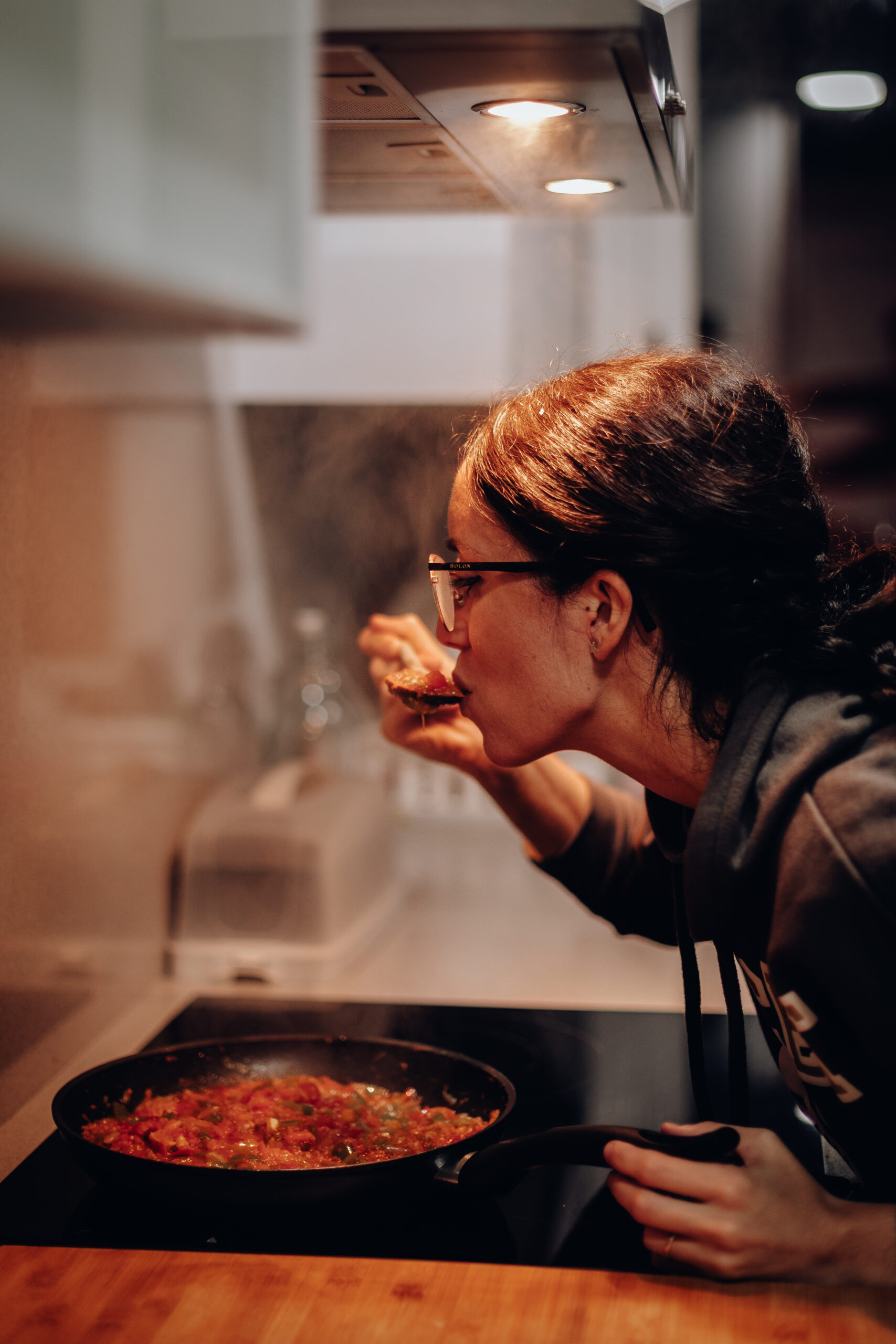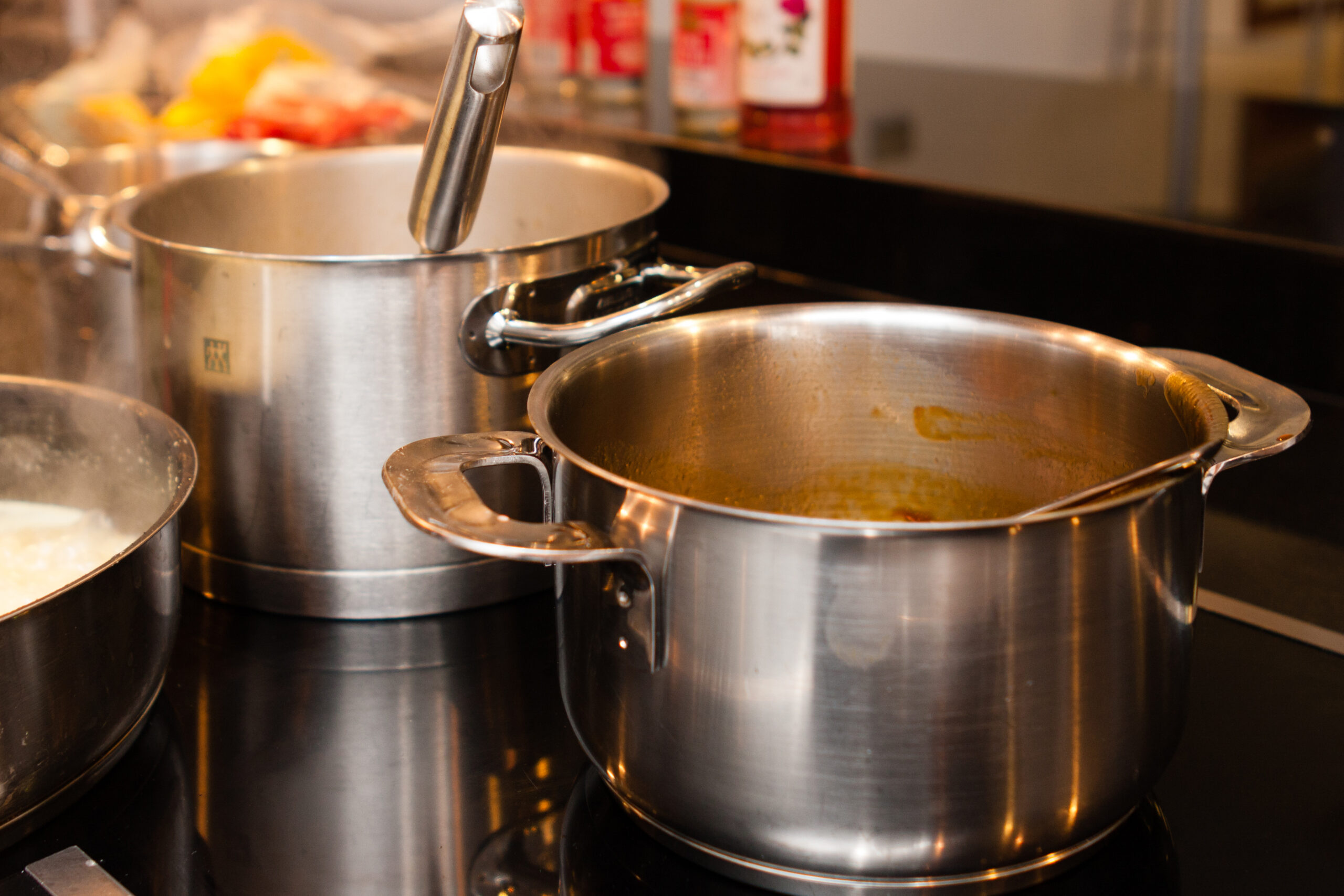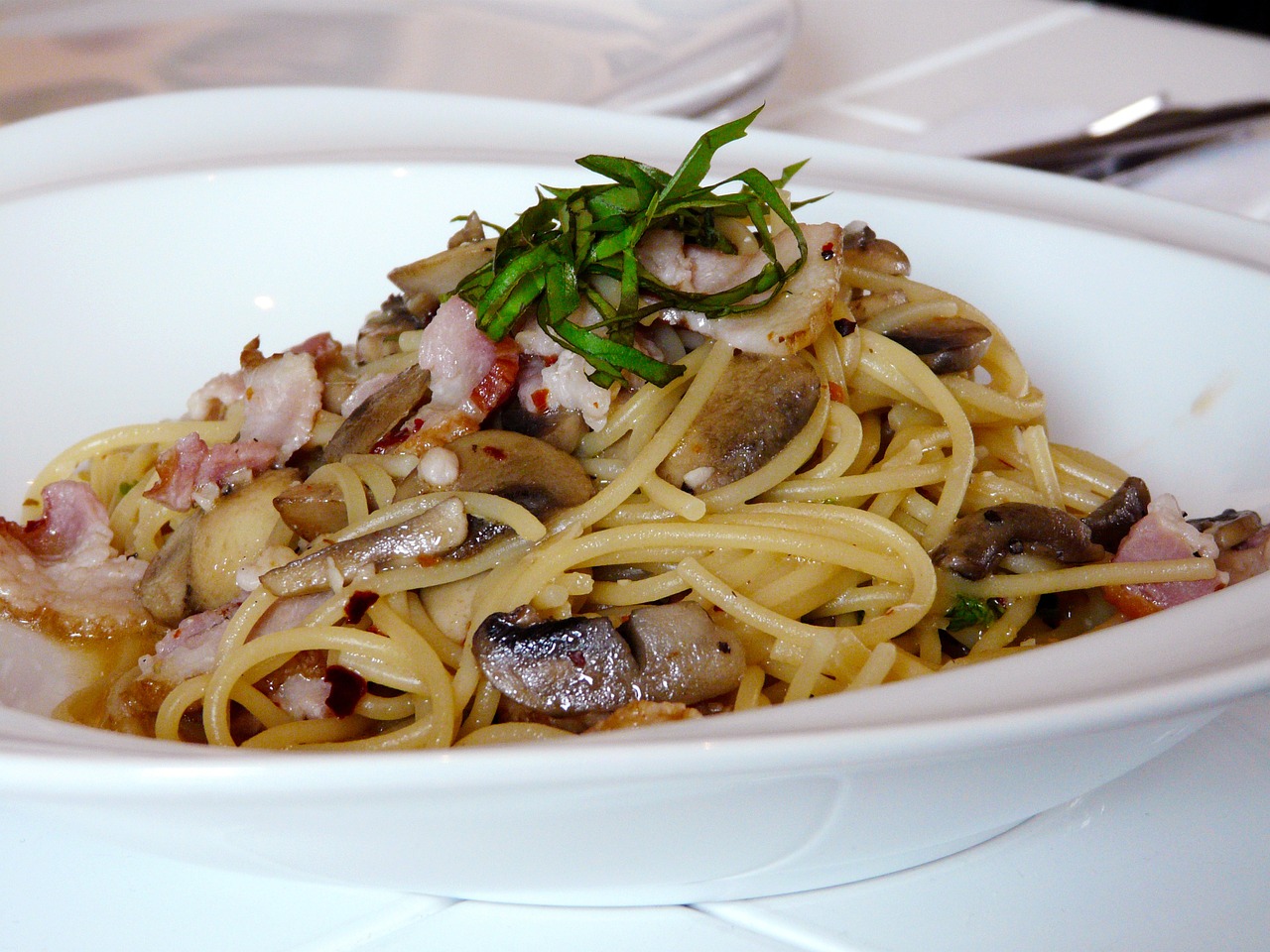Are you ready to take your spaghetti game to the next level? Look no further than “Spaghetti all’Assassina,” a specialty from Bari, Italy that is gaining popularity among American food enthusiasts.
This dish, made famous by chef Celso Laforgia, breaks the rules of traditional pasta-making with its dark and crispy spaghetti and unconventional flavors.
Laforgia’s restaurant, Urban L’Assassineria Urbana, serves dishes that go beyond Italian cuisine, and his twist on spaghetti has captivated the taste buds of locals and tourists alike.
In this article, we’ll explore the origins and preparation of this unique pasta dish, as well as some variations that Laforgia offers at his restaurant. Get ready to tantalize your taste buds with this killer pasta!
 Types of Spaghetti
Types of Spaghetti
Traditional Spaghetti
Traditional spaghetti is the classic, go-to option for many pasta lovers. Made from durum wheat semolina, this pasta is long and thin, typically measuring about 10 inches in length. It has a smooth texture and a neutral flavor that pairs well with a variety of sauces. Traditional spaghetti is versatile and can be used in a wide range of Italian dishes, from spaghetti Bolognese to spaghetti carbonara.
Whole Wheat Spaghetti
For those looking for a healthier alternative, whole-wheat spaghetti is a great choice. Made from whole-grain durum wheat, this pasta retains the bran and germ of the wheat, adding fiber and nutrients to your meal. Whole wheat spaghetti has a slightly nutty flavor and a slightly chewier texture compared to traditional spaghetti. It is a great option for those who want to incorporate more whole grains into their diet.
Gluten-Free Spaghetti
Gluten-free spaghetti is specially made for individuals who have gluten intolerance or celiac disease. This type of spaghetti is typically made from alternative flour such as rice flour, corn flour, or quinoa flour. Gluten-free spaghetti has a similar texture and taste to traditional spaghetti, making it a suitable substitute for those who need to avoid gluten. It is important to note that not all brands of gluten-free spaghetti are created equal, so it’s always a good idea to read the ingredient list and choose a reputable brand.
How to Make Spaghetti
Making spaghetti at home is a simple and satisfying process. Here’s a step-by-step guide to help you create a delicious plate of spaghetti:
- Boil water: Start by bringing a large pot of water to a rolling boil. Adding salt to the water will enhance the pasta’s flavor.
- Add spaghetti: Once the water is boiling, carefully add the spaghetti to the pot. Use tongs or a spaghetti fork to prevent the noodles from clumping together.
- Cook spaghetti: Follow the package instructions for cooking time. Typically, spaghetti takes around 8-10 minutes to cook until al dente, which means it is cooked but still slightly firm to the bite.
- Drain spaghetti: Once the spaghetti is cooked, carefully pour it into a colander to drain. Avoid rinsing the pasta, as this removes the starch that helps the sauce cling to the noodles.
- Prepare sauce: While the spaghetti is cooking, you can prepare your sauce of choice. Popular options include marinara sauce, meat sauce, Alfredo sauce, or pesto sauce.
- Combine spaghetti and sauce: Once the spaghetti is drained, return it to the pot and add the prepared sauce. Toss well to ensure that every strand of spaghetti is coated in the delicious sauce.
- Serve and enjoy: Transfer the spaghetti to plates or bowls and garnish with grated cheese, fresh herbs, or a drizzle of olive oil. Serve immediately and enjoy your homemade spaghetti!

How Do You Make Spaghetti Taste Good?
While spaghetti is a delicious dish on its own, there are several ways to enhance its flavor and make it even more enjoyable. Here are some tips to make your spaghetti taste good:
- Season the pasta water: Adding salt to the boiling water not only enhances the flavor of the pasta but also helps to season it from within. You can also add a splash of olive oil to prevent the noodles from sticking together.
- Use quality ingredients: Opt for high-quality pasta, fresh vegetables, and flavorful herbs and spices. Using fresh, ripe tomatoes for your sauce or adding fresh garlic and basil can elevate the taste of your spaghetti.
- Don’t overcook the pasta: Be sure to cook the pasta until it is al dente, meaning it still has a slight bite to it. Overcooked pasta can become mushy and lose its flavor and texture.
- Add herbs and spices: Consider adding herbs like basil, oregano, or parsley to your sauce for added depth of flavor. Spices like garlic powder, onion powder, or red pepper flakes can also enhance the taste.
- Experiment with different sauces: Don’t be afraid to try different types of sauces to add variety to your spaghetti. From creamy Alfredo sauce to spicy Arrabbiata sauce, the possibilities are endless.
- Garnish with cheese: Sprinkling grated Parmesan or pecorino cheese on top of your spaghetti adds a salty, savory kick. Experiment with different types of cheese to find your favorite combination.
Remember, taste is subjective, so feel free to adjust the ingredients and seasonings according to your personal preferences. Don’t be afraid to get creative and have fun with your spaghetti!
What’s Good to Put in Spaghetti?
Spaghetti is a versatile dish that can be customized with a variety of ingredients to suit your taste and dietary preferences. Here are some popular additions to consider:
- Vegetables: Add a colorful array of vegetables to your spaghetti for added flavor and texture. Some popular options include bell peppers, onions, mushrooms, spinach, zucchini, or broccoli. Sauté or roast the vegetables before adding them to the sauce to enhance their natural flavors.
- Meat and seafood: If you’re a meat lover, consider adding cooked ground beef, Italian sausage, meatballs, or shredded chicken to your spaghetti. Seafood lovers can add shrimp, clams, or mussels for a delicious seafood pasta dish.
- Cheese: Sprinkle-grated Parmesan, pecorino, or mozzarella cheese on top of your spaghetti. The melted cheese adds a creamy, savory touch to the dish.
- Fresh herbs: Add a pop of freshness to your spaghetti with fresh herbs like basil, parsley, or oregano. Chop them finely and sprinkle them over your spaghetti just before serving.
- Olives and capers: For a burst of briny flavor, add pitted olives or capers to your spaghetti. These ingredients work particularly well with tomato-based sauces.
- Nuts: Toasted pine nuts or chopped walnuts can add a crunchy texture and nutty flavor to your spaghetti. Sprinkle them over the dish or toss them in with the sauce.
Remember, the beauty of spaghetti is that you can customize it to your liking. Feel free to mix and match the ingredients to create your perfect plate of spaghetti.

What is a Good Spice to Add to Spaghetti Sauce?
Adding spices to your spaghetti sauce can enhance its overall flavor and make it more exciting. Here are some popular spices to consider adding to your spaghetti sauce:
- Garlic powder: Garlic adds a rich, savory flavor to spaghetti sauce. You can use either fresh minced garlic or garlic powder. Garlic powder is a convenient option as it has a longer shelf life and provides a more concentrated flavor.
- Onion powder: Onion powder adds a subtle sweetness and depth of flavor to spaghetti sauce. It pairs well with tomatoes and helps to balance out the acidity.
- Italian seasoning: Italian seasoning is a blend of dried herbs commonly used in Italian cuisine. It typically includes a mix of herbs such as basil, oregano, thyme, and rosemary. Adding Italian seasoning to your spaghetti sauce can add complexity and a traditional Italian taste.
- Red pepper flakes: For those who enjoy a touch of heat, red pepper flakes are the perfect addition. They add a subtle spiciness to the sauce without overpowering the other flavors.
- Bay leaves: Adding a bay leaf or two to your sauce while it simmers can infuse it with a subtle, earthy flavor. Just remember to remove the bay leaves before serving.
- Black pepper: A pinch of freshly ground black pepper can add a mild kick and enhance the overall flavor of your spaghetti sauce.
Remember, spices can be adjusted to suit your personal taste preferences. Start with a small amount and gradually add more as needed. Taste the sauce as you go to ensure it reaches your desired level of spiciness and flavor.
What is the Trick for Spaghetti?
The trick for spaghetti lies in the cooking process itself. Here are a few tips and tricks to achieve perfectly cooked spaghetti:
- Use a large pot: Choose a pot that is big enough to hold the spaghetti without overcrowding. Spaghetti needs plenty of water to cook and move around freely as it boils.
- Salt the water: Add a generous amount of salt to the boiling water before adding the spaghetti. This helps to season the pasta from within, enhancing its flavor.
- Stir occasionally: While the spaghetti is cooking, stir it occasionally to prevent clumping and sticking together. Stir gently with a spaghetti fork or tongs to avoid breaking the noodles.
- Don’t overcook: Be mindful of the cooking time indicated on the pasta package. Cook the spaghetti until it is al dente, which means it still has a slight bite to it. Overcooked spaghetti can become mushy and less enjoyable.
- Reserve some pasta water: Before draining the cooked spaghetti, save a cup of the starchy cooking water. This water can be used later to adjust the consistency of your sauce and help it adhere better to the spaghetti.
- Finish cooking in the sauce: Instead of completely draining the cooked spaghetti, transfer it directly to the pan with your sauce. Allow the pasta to finish cooking in the sauce for a minute or two. This helps the pasta absorb the flavors of the sauce and creates a more cohesive dish.
By following these tricks, you can ensure that your spaghetti turns out perfectly cooked and delicious every time.

Are Egg Noodles Good for Spaghetti?
Yes, egg noodles can be a delicious alternative to traditional spaghetti. Egg noodles are typically made with flour and eggs, which gives them a slightly richer flavor and a tender texture.
While they are not the traditional choice for spaghetti, they can be a tasty variation, especially in homemade pasta dishes.
Egg noodles work well with a variety of sauces, including marinara, Alfredo, or even a creamy mushroom sauce.
They have a knack for absorbing flavors and delivering a satisfying bite. If you’re feeling adventurous, you can also use egg noodles in other pasta dishes such as stroganoff or beef and noodles.
Ultimately, the choice between egg noodles and traditional spaghetti comes down to personal preference.
If you enjoy the taste and texture of egg noodles, feel free to use them as a substitute in your spaghetti recipes.
Are Raw Spaghetti Noodles Bad for You?
Raw spaghetti noodles are not necessarily bad for you, but they can be difficult to digest and may not taste as enjoyable as cooked noodles. Raw spaghetti is made from durum wheat semolina, which is a hard grain that needs to be cooked to become palatable.
Cooking spaghetti noodles makes them more tender and easier to chew and digest. Raw spaghetti may be too hard and crunchy, and it can also be challenging for your body to break down the raw starches.
Additionally, raw pasta noodles can also pose a choking hazard if not eaten carefully. The long, stiff strands of raw spaghetti can be difficult to swallow and may get stuck in your throat.
To fully enjoy the taste and texture of spaghetti, it is recommended to cook the noodles according to the package instructions. This will ensure that the noodles are cooked through and safe to consume.
Are Roma Tomatoes Good for Spaghetti Sauce?
Roma tomatoes, also known as plum tomatoes, are excellent for making spaghetti sauce. They are known for their firm texture, flavorful flesh, and low water content, making them ideal for cooking down into a rich and thick sauce.
Roma tomatoes have a concentrated tomato flavor and a good balance of sweetness and acidity, which helps to enhance the taste of your spaghetti sauce. They also have fewer seeds and less juice compared to other tomato varieties, resulting in a thicker sauce with less liquid.
When using Roma tomatoes for spaghetti sauce, it is common to blanch them first to remove the skin. This can be done by making a small “X” on the bottom of each tomato, boiling them for a minute or two, and then transferring them to an ice bath. The skin will then easily peel off, leaving you with a flavorful tomato pulp to use in your sauce.
Alternatively, you can also use canned Roma tomatoes, which are peeled and packed in their own juices. These canned tomatoes are a convenient option and can yield excellent results for your spaghetti sauce.
Overall, Roma tomatoes are a popular choice for spaghetti sauce due to their flavor, texture, and ability to create a delicious, hearty sauce.
Best Spaghetti Meat Sauce Recipe
Spaghetti meat sauce, also known as Bolognese sauce, is a rich and flavorful sauce that pairs perfectly with spaghetti. Here’s a recipe for the best spaghetti meat sauce:
Ingredients:
- 1 pound ground beef or a combination of beef, pork, and veal
- 1 onion, finely chopped
- 2 garlic cloves, minced
- 1 carrot, finely chopped
- 1 celery stalk, finely chopped
- 1 can (28 ounces) crushed tomatoes
- 1 can (6 ounces) tomato paste
- 1 cup beef or vegetable broth
- 1/2 cup red wine (optional)
- 1 teaspoon dried basil
- 1 teaspoon dried oregano
- 1/2 teaspoon salt
- 1/4 teaspoon black pepper
- 1/4 teaspoon red pepper flakes (optional)
- 1 bay leaf
- 2 tablespoons olive oil
- Fresh basil and grated Parmesan cheese for garnish
Instructions:
- Heat olive oil in a large saucepan or Dutch oven over medium heat. Add the ground beef and cook until browned, breaking it up into crumbles. Remove the beef from the pan and set it aside.
- In the same pan, add the onion, garlic, carrot, and celery. Cook until the vegetables have softened, about 5 minutes.
- Add the beef back to the pan and stir in the crushed tomatoes, tomato paste, broth, wine (if using), dried basil, dried oregano, salt, black pepper, red pepper flakes (if using), and bay leaf.
- Bring the sauce to a simmer, then reduce the heat to low. Cover and let it simmer for at least 1 hour, stirring occasionally.
- Taste the sauce and adjust the seasoning if needed. If the sauce is too thick, you can add more broth or water. If it’s too thin, let it simmer uncovered for a few more minutes to thicken.
- Remove the bay leaf before serving. Serve the spaghetti meat sauce over cooked spaghetti noodles.
- Garnish with fresh basil leaves and grated Parmesan cheese before serving.
This spaghetti meat sauce recipe can be adjusted according to your taste preferences. You can add additional vegetables, herbs, or spices to customize it to your liking. Enjoy the rich and flavorful sauce with your favorite type of spaghetti for a satisfying and comforting meal.
Happy Cooking!



